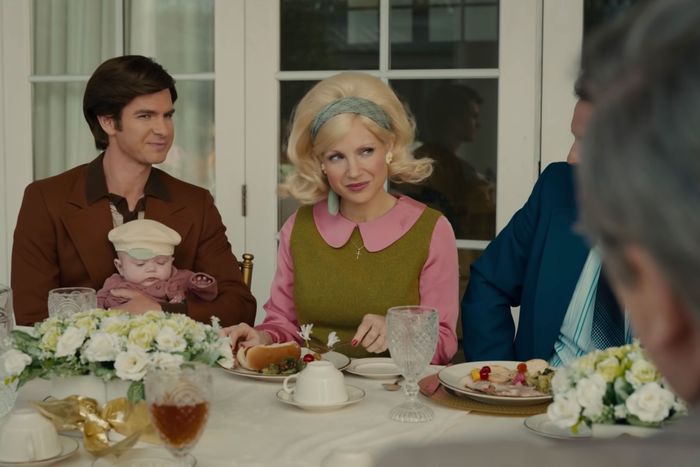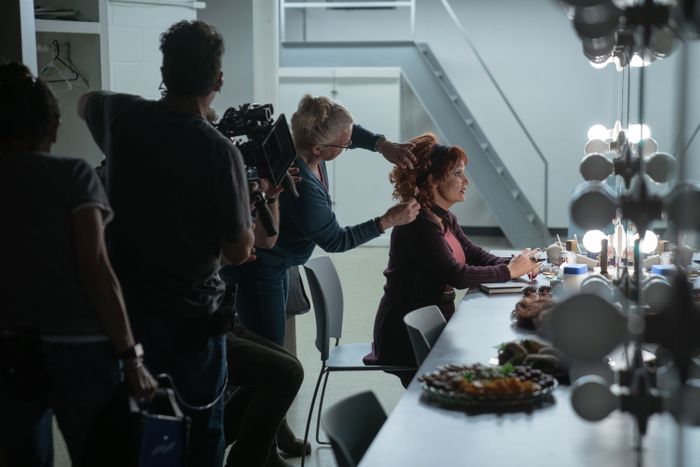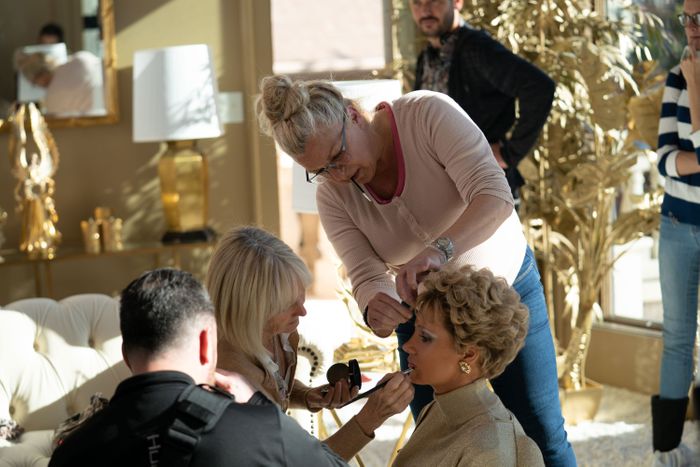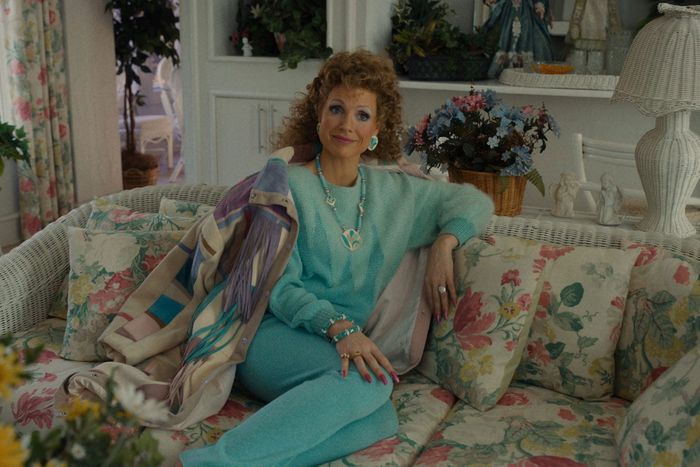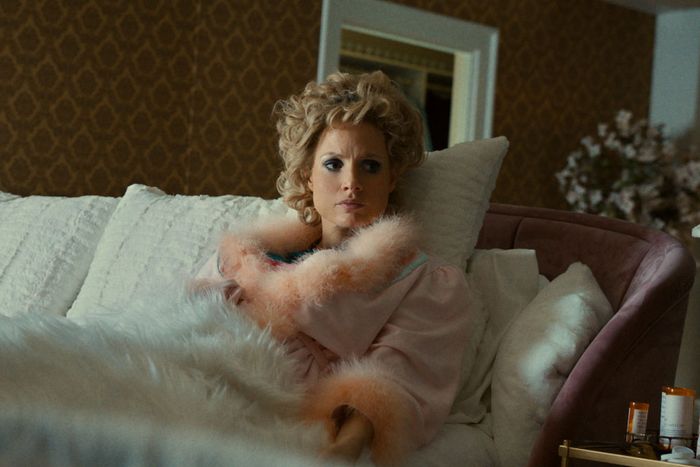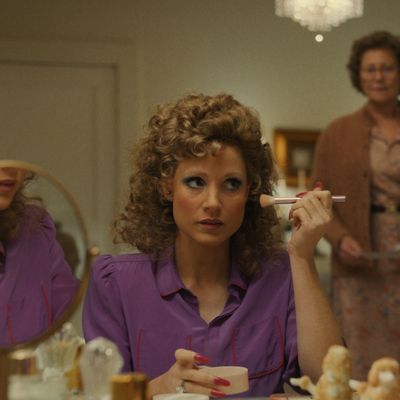
For many, Tammy Faye Bakker is synonymous with her meticulous sense of style and the tainted legacy of PTL, the scandal-prone Christian broadcasting network she co-founded and ran with her then-husband Jim Bakker through the late 1980s. Her image was always over-the-top, assembled with head-to-toe flair and diligence: big hair, matchy-matchy pastel colors and sequins, and dense, shimmery makeup atop strong cheekbones and tattooed lips and eyebrows.
It was an image often caricatured in the media after the Bakkers’ downfall. But when Jessica Chastain first watched The Eyes of Tammy Faye (2000), directors Fenton Bailey and Randy Barbato’s documentary about the famed televangelist, she saw a more complex and compassionate person than the one represented in sensationalized news stories. She decided to tell Tammy’s complete life story on her terms — and so transformed into Tammy Faye herself in a new film of the same name, directed by Michael Showalter.
Among the squad of magicians who turned Chastain into Tammy Faye are the film’s makeup department head Linda Dowds, chief hairstylist Stephanie Ingram, prosthetic-makeup designer Justin Raleigh, and costume designer Mitchell Travers. The quartet worked with the actor and with one another to avoid the clichéd, runny-mascara image of Bakker and to stay true to her style across the decades. Here’s how they did it.
The Hair: Specific
Converting Chastain’s signature flaming locks into Tammy Faye’s ever-changing and sometimes wild hair was a vast undertaking. Ingram addressed the challenge by breaking down Tammy’s hair colors and styles into decade-based segments, from the ’50s all the way into the ’90s. For the character’s earlier days, she reached for short and sweet brunette wigs, changing into voluminous blonde ’dos (with custom frost and tip, true to Tammy’s actual hair) and eventually red toupees later in life.
On the whole, the designer used 11 wigs, two of which she custom-built for Chastain for scenes that demanded specific hair-related action. An especially tricky situation came when Chastain said she wanted to be able to take her wig off to reveal Faye’s short, spiky cut. That naturally had to be another wig, one that would expose the aging Tammy’s thinning hair. “That night I went home, I could see [the finished thing] in my head, but I could not figure out how to sew it on,” Ingram recalls. She left it alone for a few minutes, then suddenly “got up and started making it. I was like, ‘Oh my goodness, it’s ready!’”
For Ingram, working hand in hand with costumer Travers was especially important, partly to make sure that her hair designs and the necks of Tammy’s dresses weren’t getting accidentally tangled. She had to be flexible, prepared, and well-researched. “So if one thing didn’t work, I had something else to rely on,” she explains. “Especially with Jessica … I knew how specific she wanted to be.”
The Makeup: Unapologetic
For Dowds, capturing Faye’s boisterous philosophy on makeup was crucial: Tammy didn’t wear makeup as a mask or to hide her real self. “It just made her happy,” Dowds says. “I do believe she felt pretty. It’s just who she was.”
That became Dowds’s starting point in shaping Faye’s gradually intensifying makeup, starting from her bright-faced Bible College days, where makeup was a taboo, through her PTL years and beyond, up until the early ’90s, when she got her lip liner and eyebrow line tattooed. “She took her cue from other TV personalities in the Evangelical world. There was a lot of big hair, big makeup.”
Dowds went from frosty blues and mauves in the ’70s and part of the ’80s into plums, purples, and burgundies, adding more taupe to her palette later. She frequently embraced pink, Tammy’s favorite color. To achieve the permanence of her tattooed lips and eyebrows, she opted for waterproof pencils. “I added another eyeliner on top of it and sometimes a little bit of shadow just to embellish. There are these incredible eyebrow stencils. They allowed us to go very deliberately and heavier with the waterproof pencil.”
Noting that Tammy bought makeup at accessible places like drugstores, Target, and swap meets, Dowds researched the era’s exact products, even supplying some of Tammy’s original go-tos from eBay (including a long-discontinued L’Oréal mascara). “But we couldn’t actually use those. They have a certain shelf life.” She matched them to the closest contemporary products instead, often consulting her “Revlon Bible” that allowed her to locate real period colors that still exist under new names today. She also bought false lashes from Ardell and lash glue from Duo, two of Tammy’s go-to brands. At times, Dowds let things get a little messy. “There’s a scene in the bedroom where she’s in her lovely, fluffy nightie and robe. She’s got an eyelash that has fallen down. We just let those things happen because they would happen in her world.”
The Prosthetics: Extreme
When it comes to re-creating a historical figure, Raleigh emphasizes the importance of balancing the hallmark elements of the real-life character and utilizing the actor playing them. His team did a number of early tests to find that perfect amalgamation, starting with an extreme look that they gradually dialed down. Raleigh eventually landed on three stages of prosthetics. Stage one was young Tammy of the ’60s, ’70s, and early ’80s, a phase that required cheek and chin prosthetics and a little translucent tape to pull Chastain’s nostrils up.
Stage two began in the mid-’80s: a full neck wrap and larger cheeks to convey weight gain. Raleigh also decreased Chastain’s lip line to start the aging process. “Stage three [was] the same format,” he explains. “Larger cheeks and chin, [and] lip prosthetics to age her. We also did a little [stretch and stipple] work” to give Chastain the age around her eyes. Still, the chief element was always the cheeks. “She has a very specific shape. That was really the number one component [through which] we transformed Jessica enough. So as long as we had the cheeks properly placed and anatomically correct, we could limit prosthetics [elsewhere].”
Because of the tricky dance between makeup and prosthetics — the former should never stain the latter — Dowds was among Raleigh’s main collaborators. “In the latter stages, [Jessica] would actually start with Linda. There’s so much makeup. You can get a lot of fallout of eye shadow. If that happens with prosthetics, it’s a disaster to try and clean it up.” Raleigh’s team also created Tammy’s whole skin foundation, with Tammy’s complexion deepening and darkening over time. “It’s always magical. You start with the person you recognize. By the end of this multi-hour process between departments, it’s truly transformative. It’s a strange psychological transformation for the actors. Looking at yourself in the mirror and not being able to truly recognize yourself is challenging. It helps them get into the performance, but takes a little getting used to.”
The Closet: Aggravating
“It’s called The Eyes of Tammy Faye, so we always wanted to see things from her perspective,” says costume designer Travers on his thoughtful approach to Tammy’s wardrobe, which he broke down into decades like the rest of the artisans. “In my mind, the good days were the most colorful with her favorite palette: pinks, greens, blues. And [leopard, because] Tammy famously said that her favorite color was leopard. [Later], the wall started to come down a little. So I used a really aggravated color palette: slashes of crimson red, cobalt blue, and some black that started to feel aggressive.”
It was vital for Travers to find the early-in-life truth of Tammy, someone with limited means but a great deal of ambition. From there, it was just a matter of evolving that truth. “We watch her flourish as she finds strength, recognition, and celebrity. It was important that it always felt like the same person, just expressing themselves more flamboyantly.” Luckily, photographs of Tammy were easy to acquire from the archives as well as her friends and family, a collection Travers studiously turned into a design bible.
To obtain the variety of suitable vintage garments and fabrics — polka dots, shimmery textiles, embellishments, and gaudy getups — Travers tapped high-end designers, online retailers, and estate sales. One serendipitous find came from a consignment store, a perfect red skirt suit to re-create one of Tammy’s famous looks on the steps of a courthouse. “It was this little divine moment where I got exactly what I needed.”
Because Tammy was “a full-look” woman (“She would have been a fantastic costume designer,” Travers says), he wanted all her pieces to be harmonized. So he worked closely with all departments, matching Dowds’s eye shadows to his own colors while navigating shoulder pads, big hair, and Tammy’s changing body shape. One lucky incident of collaboration came when he stumbled upon a package of pristine, unopened press-on nails from the ’70s in a tiny shop. “I ran to Linda, who then of course transformed them. There were a few of those [lucky] moments. I felt like [Tammy] was looking out for me, [making] sure that we got her looking the way she should.”


